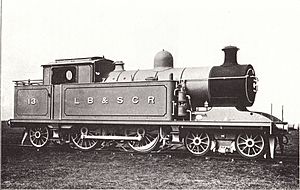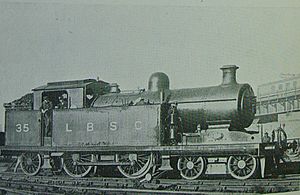- This page was last modified on 17 October 2025, at 10:18. Suggest an edit.
LB&SCR I2 class facts for kids
| LB&SCR I2 & I4 classes | |
 |
|
| Side-view builder's photo of LB&SCR I2 class 4-4-2T. | |
| Power type | Steam |
|---|---|
| Designer | D.E. Marsh |
| Builder | Brighton Works |
| Build date | 1907-1909 |
| Total production | I2: 10; I4: 5 |
| Configuration | 4-4-2T |
| Gauge | 4 ft 8 1⁄2 in (1,435 mm) standard gauge |
| Leading wheel diameter | 3 ft 6 in (1.067 m) |
| Driver diameter | 5 ft 6 in (1.676 m) |
| Trailing wheel diameter | 4 ft 0 in (1.219 m) |
| Locomotive weight | 68.5 long tons (69.6 t; 76.7 short tons) I2, 70.25 long tons (71.38 t; 78.68 short tons) I4 |
| Fuel type | Coal |
| Water capacity | 2,238 imp gal (10,170 L; 2,688 US gal) |
| Boiler pressure | 170 psi (12 bar; 1.2 MPa) |
| Cylinders | Two, inside |
| Cylinder size | 17.5 in × 26 in (444 mm × 660 mm) |
| Tractive effort | I2: 17,425 lbf (77.51 kN), I4: 17,790 lbf (79.13 kN) |
| Retired | 1933-1940 |
| Disposition | All scrapped |
The LBSCR I2 class and I4 class were types of steam tank locomotives. They were designed by D. E. Marsh for carrying passengers on local train lines for the London, Brighton and South Coast Railway. The I4 class was very similar to the I2, but it had a special part called a superheater which made the steam hotter and more powerful.
Contents
I2 Class Locomotives
In 1907, a designer named Douglas Earle Marsh wanted to fix problems from an earlier train design, the I1 class. He created a new type of steam tank locomotive called the I2 class. These trains had a longer base between their wheels and a bigger boiler.
Originally, five of these new trains were meant to have a special superheater boiler. This type of boiler makes steam even hotter and more efficient. The other trains would use traditional boilers. However, the superheated boilers were delayed. So, all ten I2 locomotives were built with the traditional boilers.
I4 Class Locomotives
When the special superheated boilers finally arrived, they were used for five more trains. These trains were built with the same design as the I2 class. But because they had the superheated boilers, they were given a new name: the I4 class.
Unfortunately, neither the I2 nor the I4 class solved the main problem of the earlier I1 class. This problem was that the firebox (where the coal burns) was too small. Because of this, both the I2 and I4 classes did not last very long in service. They were mostly used for lighter jobs on smaller train lines. Older, more reliable trains like the Stroudley D1 class and Billinton E4 class continued to be used instead.
How They Were Numbered
The London, Brighton and South Coast Railway (LB&SCR) gave these trains numbers from 11 to 20 and 31 to 35.
When the Southern Railway took over in 1923, they renumbered them. First, they added a 'B' in front, making them B11-B20 and B31-B35. Later, they changed the numbers again to 2011-2020 and 2031-2035.
When They Were Retired
All the I2 class trains were taken out of service between 1933 and 1939. However, two of them, numbers 2013 and 2019, continued to work. They were used on the Longmoor Military Railway and stayed in service until at least 1947. On this military railway, they were first numbered 2400 and 2401. Later, these numbers were changed to 72400 and 72401.
The I4 class trains were retired between 1936 and 1940. Sadly, none of these I2 or I4 class locomotives were saved. They were all eventually scrapped.
Locomotive Summary
| LB&SC Number | Built | S.R. Number | Withdrawal | Notes |
|---|---|---|---|---|
| 11 | December 1907 | 2011 | January 1933 | I2 |
| 12 | March 1908 | 2012 | March 1935 | I2 |
| 13 | April 1908 | 2013 | January 1939 | I2, became W.D. 72400 Earl Roberts |
| 14 | April 1908 | 2014 | February 1933 | I2 |
| 15 | May 1908 | 2015 | January 1936 | I2 |
| 16 | June 1908 | 2016 | September 1933 | I2 |
| 17 | July 1908 | 2017 | January 1938 | I2 |
| 18 | July 1908 | 2018 | April 1936 | I2 |
| 19 | July 1908 | 2019 | November 1937 | I2, became W.D. 72401 |
| 20 | August 1908 | 2020 | February 1936 | I2 |
| 31 | September 1908 | 2031 | January 1936 | I4 |
| 32 | November 1908 | 2032 | July 1937 | I4 |
| 33 | November 1908 | 2033 | July 1937 | I4 |
| 34 | December 1908 | 2034 | May 1940 | I4 |
| 35 | January 1909 | 2035 | February 1937 | I4 |

